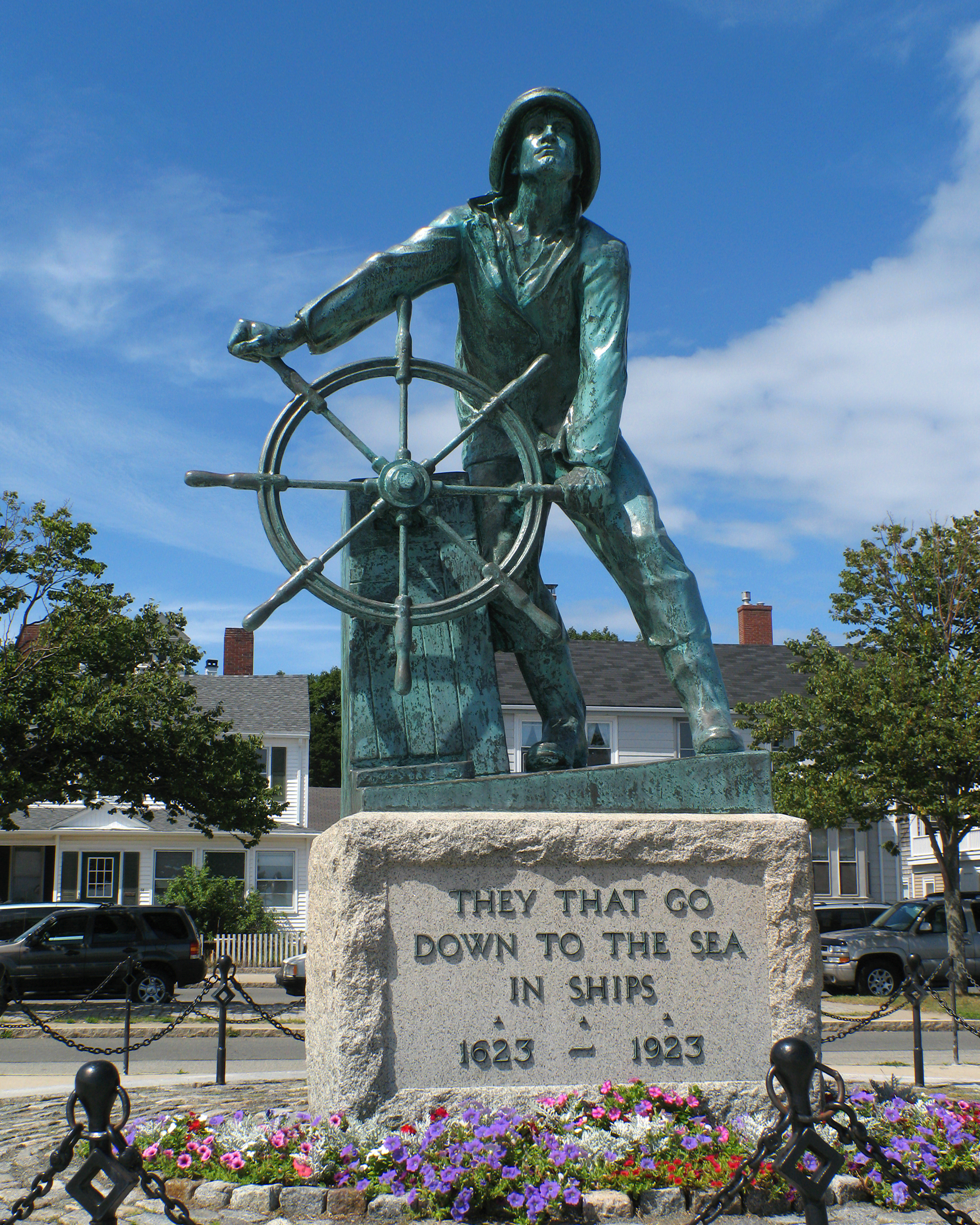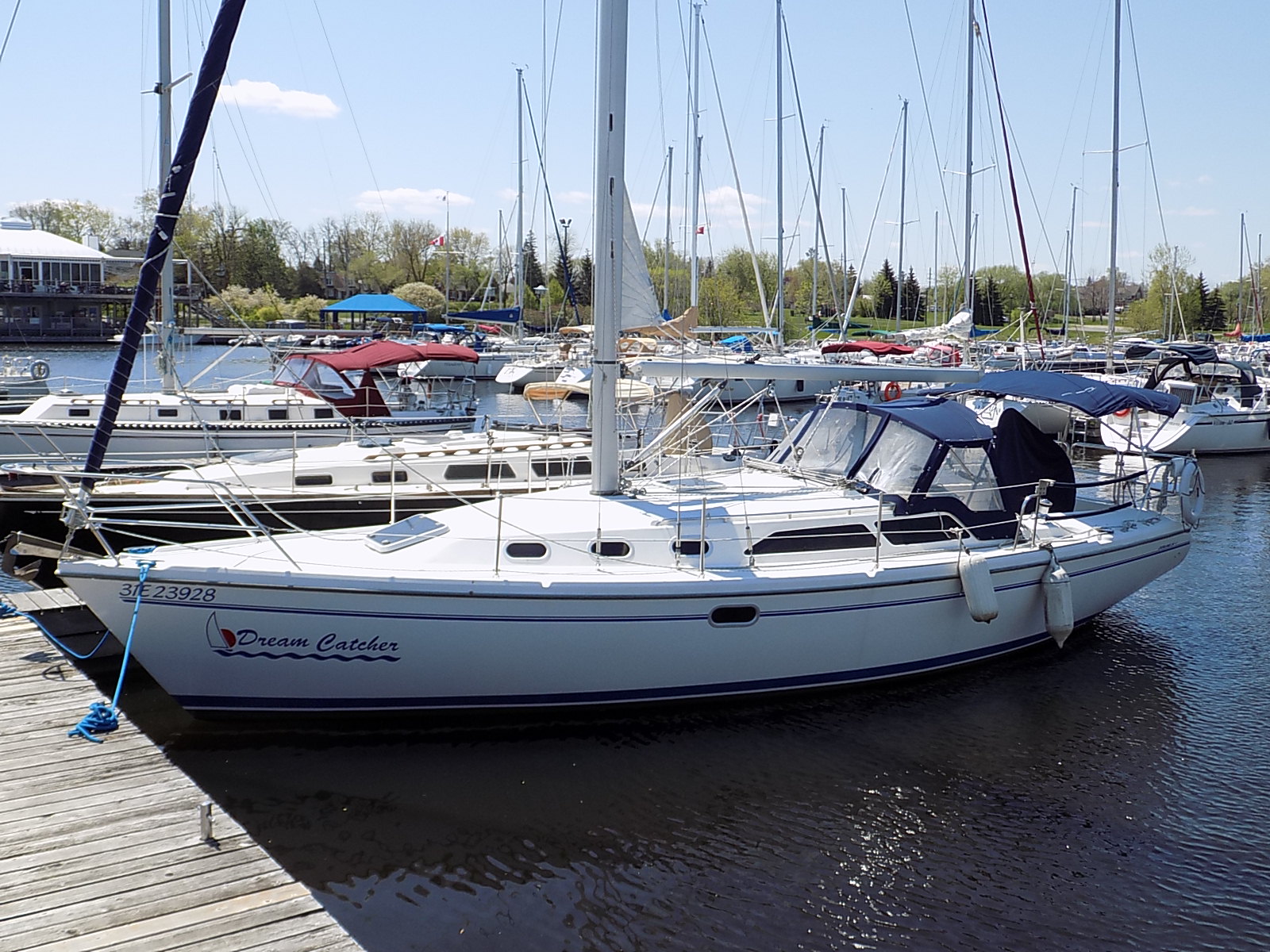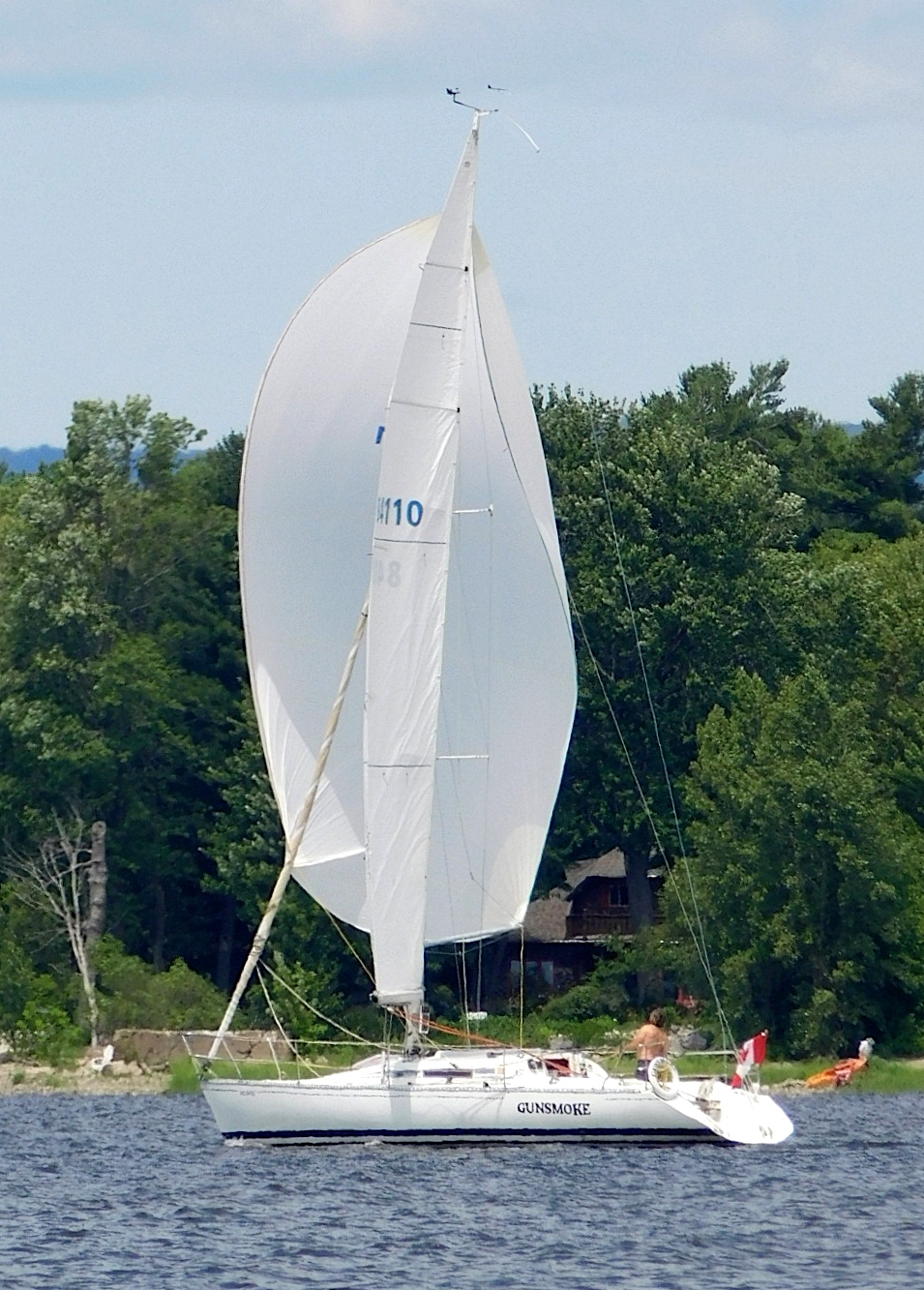|
Sea Sprite 34
The Sea Sprite 34, also called the Luders 34, is an American sailboat that was designed by Bill Luders as a cruiser and first built in 1980. The design is the largest of the series of Sea Sprite Sailing Yachts. Production The design was built by C. E. Ryder in Bristol, Rhode Island, United States. The company completed 45 examples, but it is now out of production. Design The Sea Sprite 34 is a recreational keelboat, built predominantly of fiberglass, with wood trim. It has a fractional sloop rig, with a keel-stepped mast, a spooned raked stem, a raised transom, a keel-mounted rudder controlled by a wheel and a fixed long keel. It displaces and carries of lead ballast. The boat has a draft of with the standard long keel fitted. The boat is fitted with a Universal Motor Company Model 30 diesel engine of . The fuel tank holds and the fresh water tank has a capacity of . The boat's galley is located on the port side of the cabin and includes a stainless steel sink and a ... [...More Info...] [...Related Items...] OR: [Wikipedia] [Google] [Baidu] |
Bill Luders
Alfred Edward "Bill" Luders, Jr. (December 31, 1909 – January 31, 1999) was an American naval architect, who designed all but one of the Sea Sprite Sailing Yachts. Born in Stamford, Connecticut, Luders attended The Hill School in Pottstown, Pennsylvania, then forwent further education to undertake an apprenticeship in naval architecture. Luders later became the director of the family business, Luders Marine Construction Company in Stamford, which was founded by his father, A.E. Luders, Sr., in 1908.Bill Luders Has Them Crying: Beat The Bird! ''Sports Illustrated'', July 27, 1964. In 1946, Luders was one of a committee of five boat designers (including George Hinman, Arthur Knapp, Emil "Bus" Mosbacher and Cornelius Shields) who codified and regulated the [...More Info...] [...Related Items...] OR: [Wikipedia] [Google] [Baidu] |
Ship's Wheel
A ship's wheel or boat's wheel is a device used aboard a water vessel to steer that vessel and control its course. Together with the rest of the steering mechanism, it forms part of the helm. It is connected to a mechanical, electric servo, or hydraulic system which alters the horizontal angle of the vessel's rudder relative to its hull. In some modern ships the wheel is replaced with a simple toggle that remotely controls an electro-mechanical or electro-hydraulic drive for the rudder, with a rudder position indicator presenting feedback to the helmsman. History Until the invention of the ship's wheel, the helmsman relied on a tiller—a horizontal bar fitted directly to the top of the rudder post—or a whipstaff—a vertical stick acting on the arm of the ship's tiller. Near the start of the 18th century, a large number of vessels appeared using the ship's wheel design, but historians are unclear when the approach was first used. Design A traditional ship's wheel is comp ... [...More Info...] [...Related Items...] OR: [Wikipedia] [Google] [Baidu] |
Coast 34
The Coast 34 is a Canadian sailboat that was designed by Bruce Roberts and Grahame Shannon as a cruiser and first built in 1980.Sherwood, Richard M.: ''A Field Guide to Sailboats of North America, Second Edition'', pages 266-267. Houghton Mifflin Company, 1994. The Coast 34 is a development of an earlier Roberts design for amateur construction. The design was also sold as the Passage 34, Roberts 34, and the Westcoast 34. Production The design was possibly first built by Clearwater Marine and was later constructed by Cape Marine and Windward Marine in Canada, but it is now out of production. Design The Coast 34 is a recreational keelboat, built predominantly of fibreglass, with a foam core used in the hull above the waterline. It also has wooden trim. The design has a masthead sloop rig, or optional cutter rig, with aluminum spars, a spooned raked stem, a rounded bulbous transom, a skeg-mounted rudder controlled by a wheel and a fixed fin keel. It displaces and carri ... [...More Info...] [...Related Items...] OR: [Wikipedia] [Google] [Baidu] |
Catalina 34
The Catalina 34 is an American sailboat designed by Frank V. Butler and first built in 1985. The design is out of production. Production The boat was built by Catalina Yachts in the United States, which completed 1,438 examples. Design The Catalina 34 is a recreational keelboat, built predominantly of fiberglass, with wood trim. It has a masthead sloop rig, an internally-mounted spade-type rudder and a fixed keel. The boat has a hull speed of . Variants ;Catalina 34 Mk I :Original model introduced in 1985. It displaces and carries of ballast. The boat has a PHRF racing average handicap of 138 with a high of 153 and low of 114. Boats built from 1985-86 have deck-stepped mast and a Universal diesel engine of . The boat has a draft of with the standard fin keel. Boats built between 1987-1990 have a keel-stepped mast and a Universal 25XP diesel engine of . Boats built between 1990-1991 have a walk-through transom and a Universal M35 diesel engine of . The last Mk I models p ... [...More Info...] [...Related Items...] OR: [Wikipedia] [Google] [Baidu] |
C&C 34/36
The C&C 34/36 is a Canadian sailboat series, designed by Robert W. Ball and first built in 1989. Ball was the chief designer for C&C Yachts between 1969 and 1991.Sherwood, Richard M.: ''A Field Guide to Sailboats of North America, Second Edition'', pages 278-279. Houghton Mifflin Company, 1994. Production The boat was built by C&C Yachts in Canada, but it is now out of production. When it was originally introduced it was called the C&C 34, but it replaced the 1977-vintage C&C 34 in production. Design The C&C 34/36 series are all recreational keelboats, built predominantly of fiberglass, with wood trim. They all have masthead sloop rigs, reverse transoms and internally-mounted spade-type rudders. The line was introduced in 1989. The series includes the "+" version, which is a club racer-cruiser, the "R" version, which is a deep keel racing model and a later "XL" model, which combined the performance of the "R" with a cruising interior. There was also the option of a wing kee ... [...More Info...] [...Related Items...] OR: [Wikipedia] [Google] [Baidu] |
C&C 34
The C&C 34 is a Canadian sailboat, that was designed by Robert W. Ball and first built in 1977. The design was replaced in the C&C line in 1989 by a new Robert Ball design, the C&C 34/36. Production The boat was built by C&C Yachts in Canada, but it is now out of production. Design The C&C 34 is a small recreational keelboat, built predominantly of fiberglass, with wood trim. It has a masthead sloop rig, an internally-mounted spade-type rudder and a fixed fin keel or centreboard. It displaces and carries of lead ballast. The boat has a draft of with the standard keel, with the optional deep keel. There was also an optional stub keel and centreboard version. That version has a draft of with the centreboard extended and with it retracted. The boat is fitted with a Universal Atomic 4 gasoline engine. The fuel tank holds and the fresh water tank has a capacity of . The design has a PHRF racing average handicap of 105 with a high of 117 and low of 93. It has a hull s ... [...More Info...] [...Related Items...] OR: [Wikipedia] [Google] [Baidu] |
Beneteau First Class 10
The Beneteau First Class 10 is a French sailboat that was designed by Jean Marie Finot of Groupe Finot and Jacques Fauroux as a racer/ cruiser and first built in 1982. Production The design was built by Beneteau in France between 1982 and 1987, with a total of 114 boats completed, but it is now out of production. Design The Beneteau First Class 10 is a recreational keelboat, built predominantly of solid fiberglass, with the deck made from balsa-cored fiberglass, with teak wooden trim. It has a 7/8 fractional sloop rig, with a double-spreader mast made by Z-Spar of France and stainless steel wire rigging. The hull has a raked stem, a walk-through reverse transom, an internally mounted spade-type rudder controlled by a tiller and a fixed fin keel. It displaces and carries of ballast. The boat has a draft of with the standard keel and is fitted with a Japanese Yanmar 2GM diesel engine for docking and maneuvering. The engine is mounted amidships, just above the keel and ... [...More Info...] [...Related Items...] OR: [Wikipedia] [Google] [Baidu] |
Beneteau 331
The Beneteau 331 is a French sailboat that was designed by Group Finot/Conq for cruising and first built in 1999. The Beneteau 331 has also been marketed as the Oceanis 331, Oceanis Clipper 331 and Moorings 332. The design replaced the Oceanis 321 in the company's line. Production The design was built by Beneteau in France and in the United States, with 822 examples completed between 1999 and 2004, but it is now out of production. It was introduced in 1999 as a 2000 model. Design The Beneteau 331 is a recreational keelboat, built predominantly of solid fiberglass with the deck balsa-cored. It has a masthead sloop rig, aluminum spars, a deck-stepped mast, a raked stem, a walk-through reverse transom, an internally mounted spade-type rudder controlled by a wheel and a fixed fin keel, shoal draft keel or lifting keel. It can be equipped with a spinnaker of . The interior layouts vary, based on the model and role, but a typical layout has sleeping accommodation for four to ... [...More Info...] [...Related Items...] OR: [Wikipedia] [Google] [Baidu] |
Sea Sprite 27
The Sea Sprite 27, also called the Sea Sprite 28 and the Luders 28, is an American sailboat that was designed by Bill Luders as a cruiser and first built in 1960.Sherwood, Richard M.: ''A Field Guide to Sailboats of North America, Second Edition'', pages 194-195. Houghton Mifflin Company, 1994. The Sea Sprite 27 design is one of the Sea Sprite Sailing Yachts series of boats. Production The design was built by C. E. Ryder in Bristol, Rhode Island, United States between 1960 and 1985, but it is now out of production. Design The Sea Sprite 27 is a recreational keelboat, built predominantly of fiberglass, with teak wooden trim. It has a 7/8 fractional sloop rig, a spooned raked stem, a raised transom, a keel-mounted rudder controlled by a tiller and a fixed long keel. It displaces and carries of ballast. The boat has a draft of with the standard long keel fitted. The boat is fitted with a Universal Motor Company diesel engine of . The fuel tank holds and the fresh water t ... [...More Info...] [...Related Items...] OR: [Wikipedia] [Google] [Baidu] |
List Of Sailing Boat Types
The following is a partial list of sailboat types and sailing classes, including keelboats, dinghies and multihull ( catamarans and trimarans). Olympic classes World Sailing Classes Historically known as the IYRU (International Yacht Racing Union), the organization evolved into the ISAF (International Sailing Federation) in 1996, and as of December 2015 is now World Sailing. Dinghies Keelboats & yachts Multihulls Boards Radio-controlled Former World Sailing-classes Dinghies Keelboats & yachts Multihulls Boards Other classes and sailboat types Dinghies Keelboats & yachts Multihulls See also * Classic dinghy classes * List of boat types * List of historical ship types * List of keelboat classes designed before 1970 * Olympic sailing classes * Small-craft sailing * Clansman 30 Notes References {{DEFAULTSORT:Sailing boat types Types * Boat types A boat is a watercraft of a large range of types and sizes, but ge ... [...More Info...] [...Related Items...] OR: [Wikipedia] [Google] [Baidu] |
Hull Speed
Hull speed or displacement speed is the speed at which the wavelength of a vessel's bow wave is equal to the waterline length of the vessel. As boat speed increases from rest, the wavelength of the bow wave increases, and usually its crest-to-trough dimension (height) increases as well. When hull speed is exceeded, a vessel in displacement mode will appear to be climbing up the back of its bow wave. From a technical perspective, at hull speed the bow and stern waves interfere constructively, creating relatively large waves, and thus a relatively large value of wave drag. Ship drag for a displacement hull increases smoothly with speed as hull speed is approached and exceeded, often with no noticeable inflection at hull speed. The concept of hull speed is not used in modern naval architecture, where considerations of speed/length ratio or Froude number are considered more helpful. Background As a ship moves in the water, it creates standing waves that oppose its movement. T ... [...More Info...] [...Related Items...] OR: [Wikipedia] [Google] [Baidu] |
Head (watercraft)
The head (pl. heads) is a ship's toilet. The name derives from sailing ships in which the toilet area for the regular sailors was placed at the head or bow of the ship. Design In sailing ships, the toilet was placed in the bow somewhat above the water line with vents or slots cut near the floor level allowing normal wave action to wash out the facility. Only the captain had a private toilet near his quarters, at the stern of the ship in the quarter gallery. The plans of 18th-century naval ships do not reveal the construction of toilet facilities when the ships were first built. The Journal of Aaron Thomas aboard HMS ''Lapwing'' in the Caribbean Sea in the 1790s records that a canvas tube was attached, presumably by the ship's sailmaker, to a superstructure beside the bowsprit near the figurehead, ending just above the normal waterline. In many modern boats, the heads look similar to seated flush toilets but use a system of valves and pumps that brings sea water into the toi ... [...More Info...] [...Related Items...] OR: [Wikipedia] [Google] [Baidu] |






